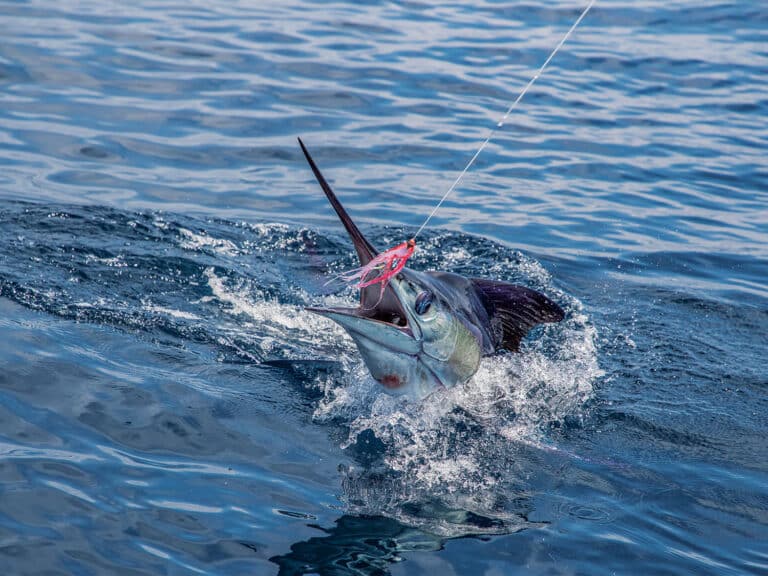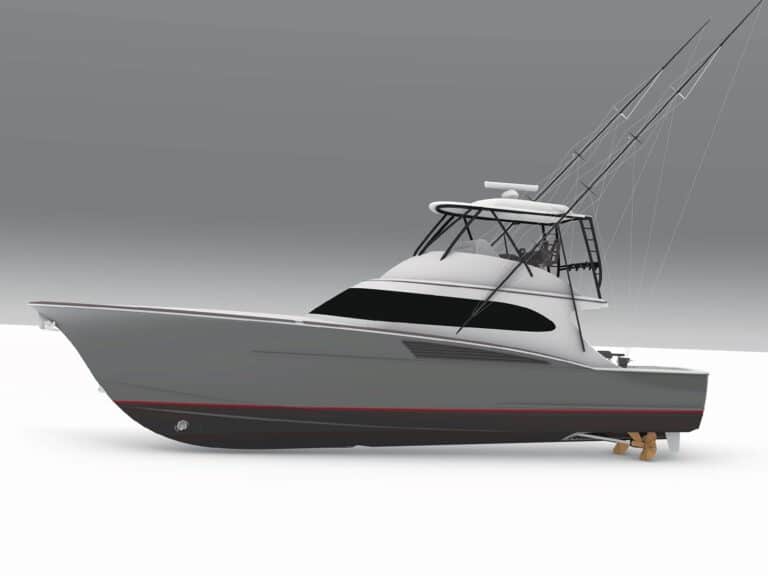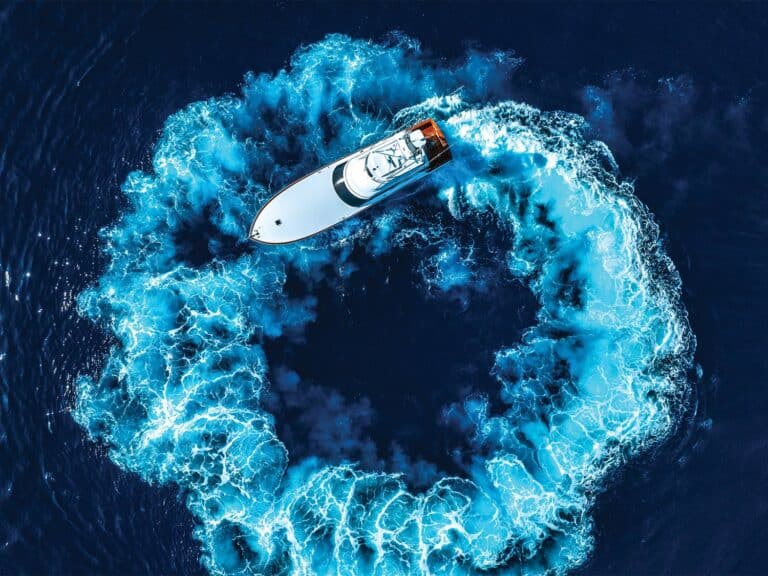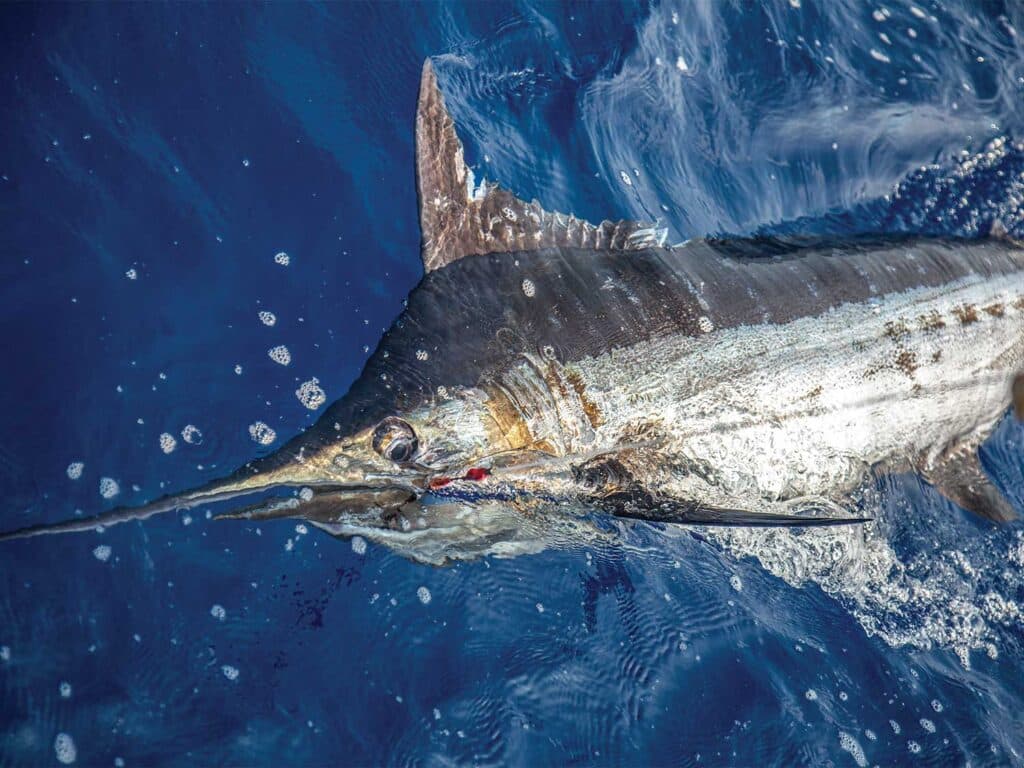
Special delivery: Sign up for the free Marlin email newsletter. Subscribe to Marlin magazine and get a year of highly collectible, keepsake editions – plus access to the digital edition and archives.
As the lights of the Azorean capital of Ponta Delgada faded into the colors of the sunset, a thousand miles of open ocean lay between our bow and the next piece of dry land. While it was a beautiful sight that inspired tremendous excitement about the adventure ahead, it’s also one that can fill your head with a million concerns. You know that nagging feeling when you can’t remember if you locked the door before you left town? Imagine that amped by a factor of a thousand. Nonetheless, we proceeded with confidence, our preparation regimen already tested between the islands of the Azores, where we had to replace a Vulkan coupler.
Even after we made multiple crossings on Sea Weez and triple-checked our gear, systems and provisions, the unknowns of fishing and traveling through remote areas can be daunting. Many fishermen dream of going to exotic billfish hotspots in search of giant fish or big numbers, but those who haven’t done it yet may underestimate what goes into planning and preparing for a long trip in foreign waters.
When it comes to outfitting a sportboat for long-distance trips, the preparation you put in before leaving the dock will make the difference between success and failure. While you can never account for every single scenario that might arise, you can get ahead of the most likely disruptions, and that typically starts with your packing.
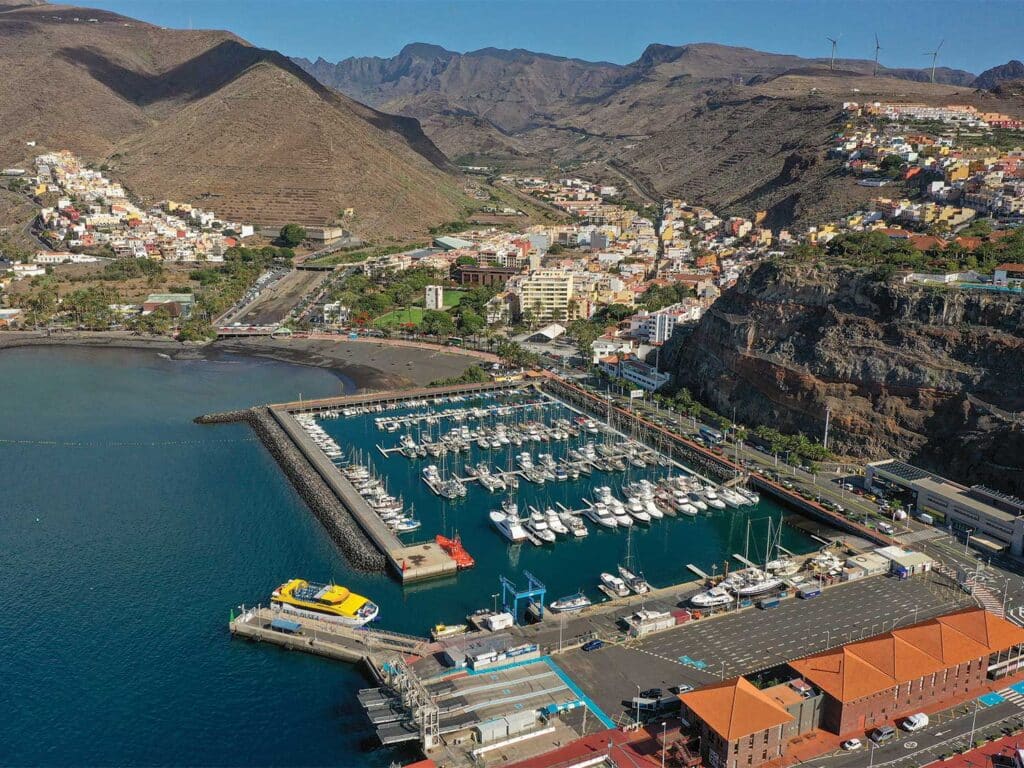
No matter how large your vessel, every inch of space represents valuable real estate. Prioritizing your packing list and storing everything efficiently and effectively will play a key role in your ability to respond to dynamic situations. What follows will by no means be a complete list, but it does highlight important elements to keep in mind if you’re considering traveling on your own hull.
Safety First
Just like on any day offshore, safety should be your No. 1 concern, and your risks and level of danger will always escalate in unfamiliar waters. While it should go without saying, I’ll say it anyway: Make sure your safety equipment, such as life rafts, flares, an EPIRB, life jackets, survival suits and fire extinguishers, is accessible and in working order, and your crew knows where to find it and how to use it. A ditch bag with all the essentials is also imperative: a handheld VHF radio, a PLB, flares, a medical kit, basic fishing gear, a mirror and provisions. Stock up on over-the-counter medications that may be hard to find outside the US, as well as prescription medications to deal with the most likely health complications: infections, stomach bugs or the flu. You’ll want plenty of bandages and various wound dressings, as well as topical medicines like Neosporin and Benadryl. Specialized, prepackaged medical kits from companies such as D-Dey Response Group can save you time.
Many modern boats are equipped with the latest electronics that will definitely come in handy when navigating unfamiliar waters. Radar and GPS systems with integrated AIS, night-vision cameras, digital and updated navigation systems, and autopilot are extremely useful. That doesn’t mean you should throw away your paper charts and disregard the compass. It’s always a good idea to have a physical reference when it comes to navigation, and you never know when an electrical issue or lightning strike could render all your electronics useless. The attitude that “it won’t happen to me” is a recipe for disaster.
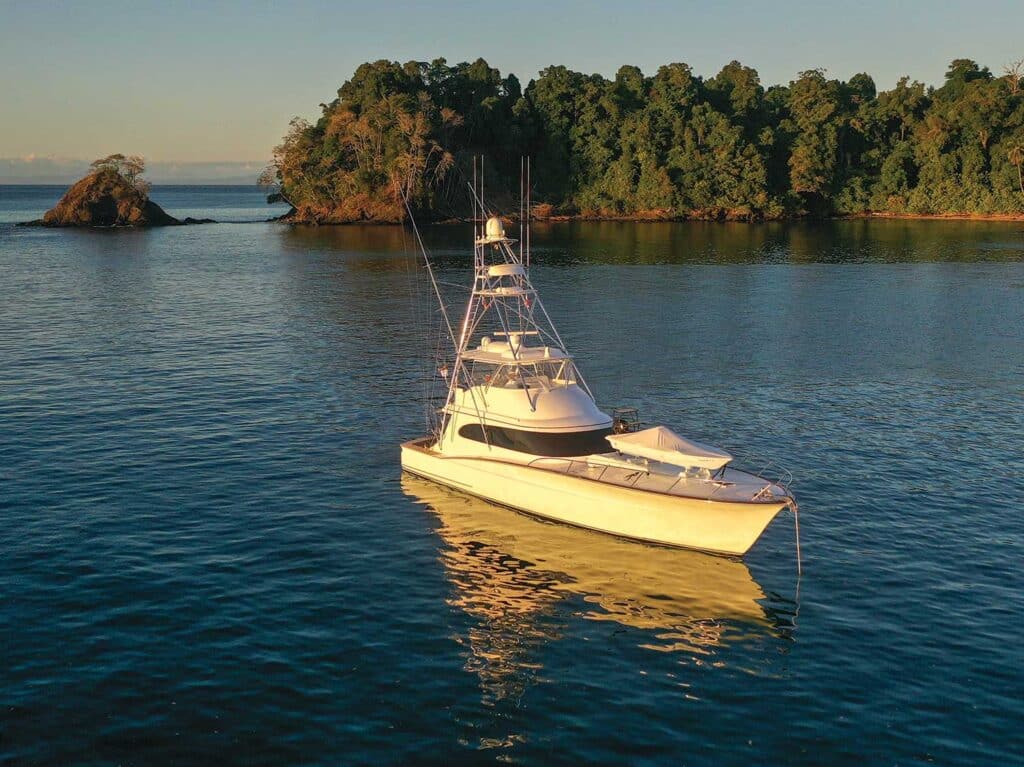
An often overlooked safety provision is your anchor setup. Be sure that your anchor, chain and rope are adequate to hold in various bottom types. Even if you don’t plan to stay on the pick, your anchor needs to be suitable and accessible in an emergency. Some don’t like the look of an anchor hanging off the bow, but dragging a heavy anchor out from down below in a critical situation is far from ideal. The same goes for a bow rail. You may not find them aesthetically pleasing, but I think they look awesome when the wind is blowing 30 knots and I’m trying to set an anchor without going over the side.
Starlink is a tech advancement that has truly been a game-changer for traveling boats. The ability to have reliable internet while in far-flung locations or long distances offshore has been revolutionary for a number of reasons, safety being at the top of the list. Being able to get weather in real time, as well as emails, calls and texts, is huge. Even being able to stream a movie on a long crossing helps combat boredom and complacency when all you’ve seen is water for multiple days. We have used Starlink in remote areas of Panama and Costa Rica as well as all over the East Atlantic and have found very few dead zones. That being said, I still recommend keeping a satellite phone or service such as Garmin’s InReach as a backup in case of emergency.
Keep It Running
Being prepared for the unexpected is obviously the theme here, and nowhere is that more crucial than in the boat’s mechanical and electrical systems. Sea Weez Capt. Ross Finlayson stresses the need for redundant systems and extra parts when traveling. If you don’t have power, refrigeration or air conditioning, you’re probably not doing much fishing. Sea Weez is outfitted with two generators, two watermakers, two power-converter boxes and water pumps that can be changed quickly if one goes down. We also carry as many spare parts as we can fit because, as Finlayson says, “You’re better off looking at it than looking for it.”
We carry plenty of fuel and oil filters for the mains and generators as well as enough oil for a full oil change, and spare empty buckets to store old oil. Your mechanical list should also include extra hoses and belts with all the fittings and hose clamps they require. A full toolkit should be on board to fix anything that may arise. Like many other traveling boats, we also carry a spare set of wheels in custom prop boxes that ride in the cockpit until we get to our destination. If you’re running out of space, a company such as National Marine Suppliers (in Fort Lauderdale, Florida) can store extra parts or supplies and ship them to you upon request.
When planning a trip, it’s important to research the marinas you’ll be visiting. Know the type of power that your destination will have, and be prepared with multiple cords or adapters based on the types of plugs they require. Also, determine if the power is single- or three-phase, and make sure your boat is set up accordingly. Marinas in foreign countries are often not equipped to meet the standards we get accustomed to in the US, so it’s not uncommon to have only one leg of power at your slip, or even to be forced to run your generator while at the dock. If you experience the latter, the hours on your generator will rack up quickly, so be prepared for more-frequent oil changes and service on your generators. Extra water hoses and multiple types and sizes of connection fittings could also be necessary for dockside water hookups.
You might also run into some uncommon tie-up situations, such as having to tie the bow off to a mooring buoy or assist lines, or any number of dock configurations—from floating docks to concrete walls and various mixes of pilings, cleats and bollards. Be prepared with plenty of lines of various lengths as well as a variety of fender sizes and styles so that you’re ready for any situation. And bring extras, just in case you break something.
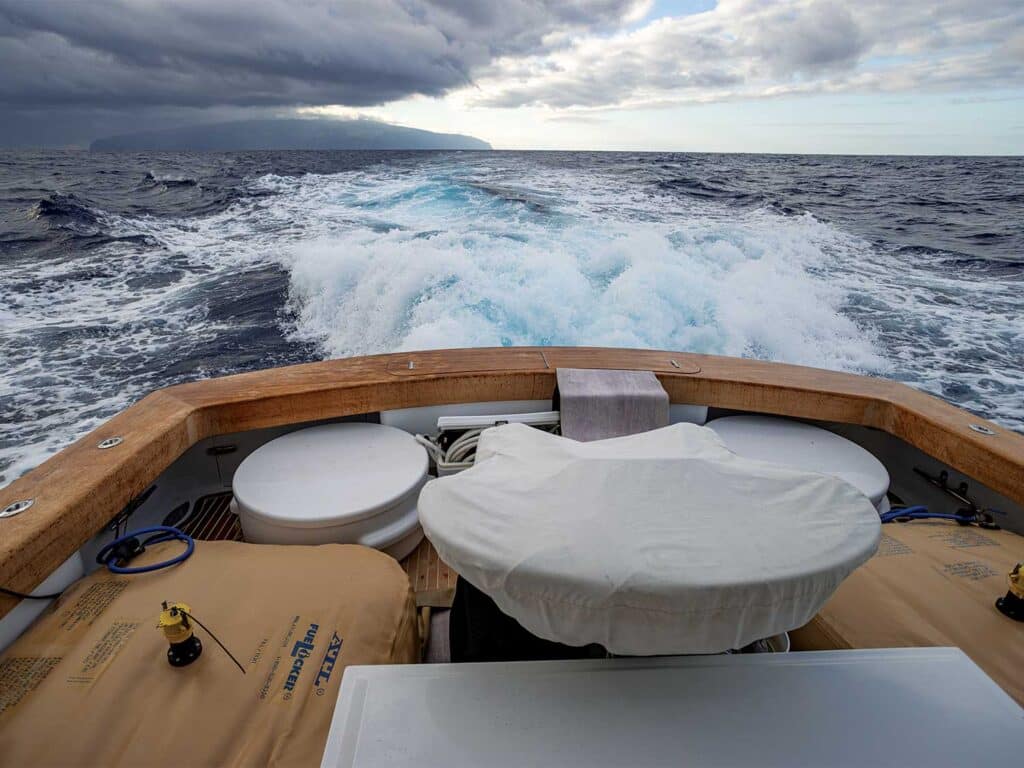
Fuel is another major factor that obviously needs to be planned out for your travels. If you’ve got long transits, then you’ll want to carry fuel bladders to ensure you have sufficient range to get you to your destination safely. On Sea Weez, we carry two 200-gallon bladders that fit well in our cockpit between the prop boxes and the other gear we carry. Many options in both size and shape exist to fit your space and consumption needs. Be sure you measure your usable space and take into consideration other items you intend to carry on deck to ensure everything will fit and can be secured. Some boats opt to carry bladders on the foredeck, but we prefer the security that the cockpit affords in heavy seas. For our bladder setup we use an electric pump to transfer fuel from the bladders to the main fuel tanks; you might want to consider an automatic system if you’ll be using the bladders frequently.
Finally, we carry at least one dive tank and a hookah system for underwater jobs that might arise: clearing a rope or line wrapped up in the wheels, cleaning and checking the sea chest, or checking rudders and trim tabs. If you have to use it even once during your trip, you’ll be happy you didn’t have to perform those types of tasks one breath at a time.
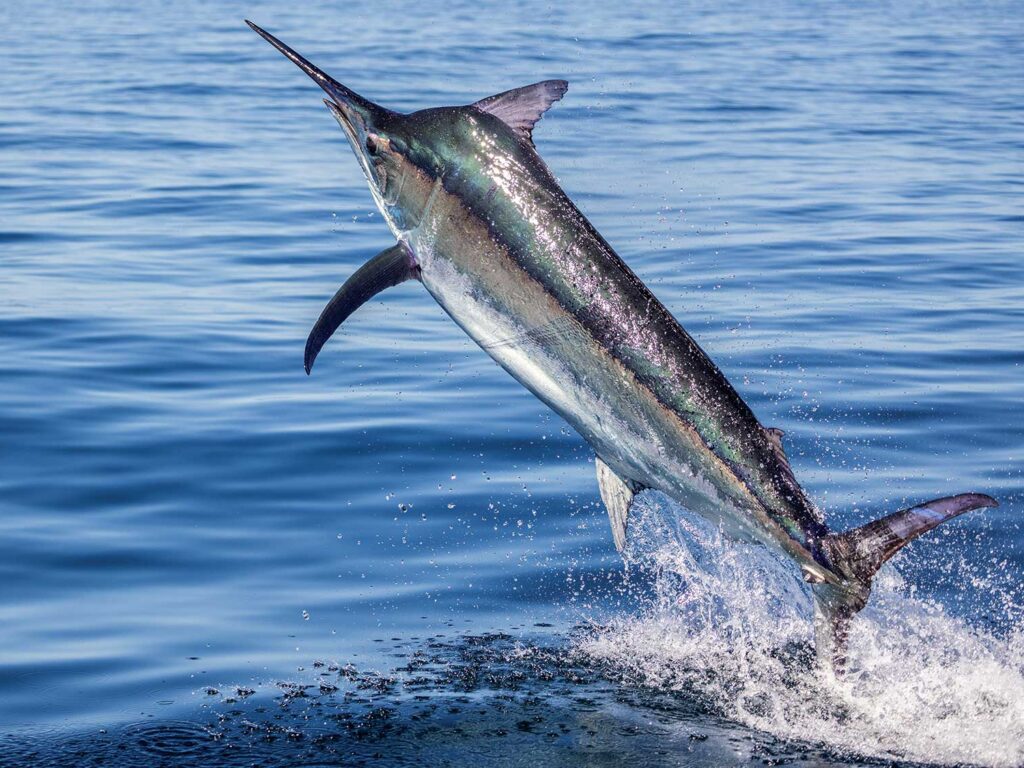
The Fun Part
All the hours of planning and preparation are worth it when that first blue marlin shows up in the spread. To make sure you’re getting bites throughout the entire trip, though, take extras of everything. On Sea Weez, we carry a tackle shop’s worth of gear on board at any given time. Stock up on essentials, especially those that have short life spans or are easy to lose, such as rigging needles. Put together a box of spare outrigger parts; if something breaks, you won’t be down a rigger. Take tons of the basics, such as leader material, hooks, swivels, crimps, weights, rigging floss, and extra spools of line. If you’re fishing in an area where you’d likely deal with plenty of toothy critters such as sharks and barracudas, then plan to go through plenty of lure skirts too.
In all aspects of packing, but especially with tackle, a label maker and properly sized storage containers can be a lifesaver. Knowing what goes where helps you find what you need rapidly and keeps the boat from becoming an unorganized disaster. Choose storage containers in sizes and shapes that maximize your available spaces. Label the boxes and use clear containers so you can see what’s inside them. This will help immensely when you’ve got your hands full and send someone to search for something. Map your storage strategically by putting the items you use daily in the most accessible locations. We keep day boxes of crimps and tools in our cockpit drawers, a larger selection in the salon couch, and bulk storage in the cabinets forward. I find that keeping a running inventory helps maintain optimal levels without purchasing unnecessary items.
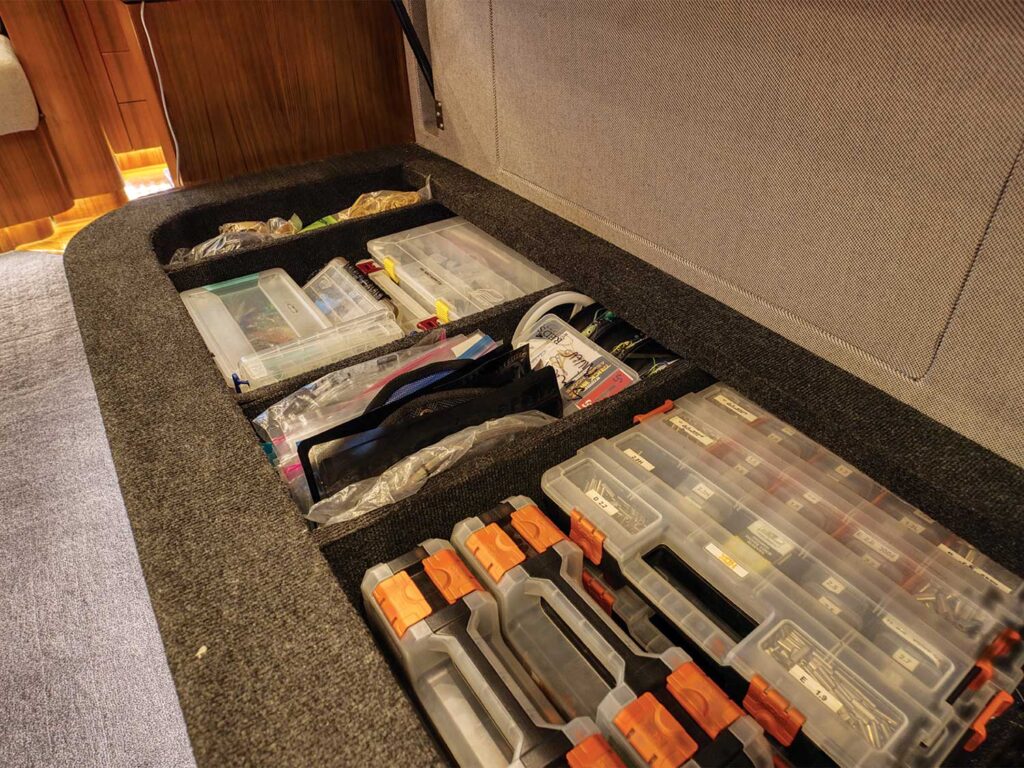
Bait must be considered carefully in your planning. If you’re catching your own, you’ll need to account for the potential of mangled nets and pack plenty of various-size sabiki rigs, since they’re swapped out often. Dead-bait anglers will need to allow for plenty of freezer space and be smart about the quantities they purchase.
Lure fishermen should have spares for favorite colors or shapes; losing that one special lure can crush your confidence in the middle of a hot bite if you don’t have a ready replacement available. If loading your boat on a ship, be sure to know the company’s policy on keeping the boat powered during transit before you pack your freezers full.
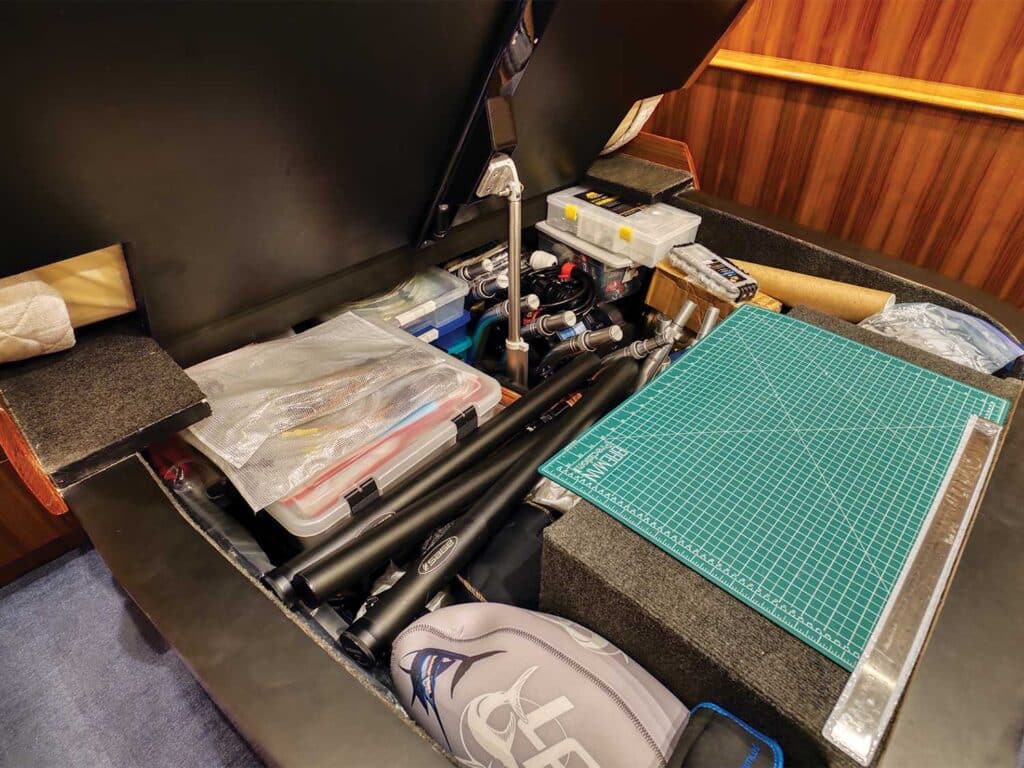
Other Essentials
Many of the choices you make about what to bring or leave home will depend on the preferences of your crew and guests. A crowd of hardcore fishermen that are happy to rough it will have a much different packing list than a boat owner who wants a more luxurious experience. Your shopping list will depend on what’s available at your destination, but essentials such as paper towels, toilet paper, condiments, toothpaste and razors should not be overlooked, especially if you’re traveling somewhere remote. A similar approach goes for food. If your crew is picky about specific brands or cuts of meat, then vacuum-seal them and bring them along. If you’re going to be out of the country for a long time, it’s especially nice for each crewmember to have at least one or two of their favorite treats from home.
One thing that we have on Sea Weez that has been particularly beneficial is a drinking-water filtration system that has taps in both the galley and the cockpit. This allows us to use refillable bottles for drinking water and not have to dedicate valuable cooler space to bottled water or deal with the trash of plastic bottles once they’re empty. Paired with a watermaker, this gives us a virtually unlimited supply of clean drinking water.
A portable gas grill is also well worth the space it occupies; the standard small Weber is a fixture on many docks because of its size and durability. You’ll also want to bring cleaning products and plenty of rags and towels. Another item Finlayson relies on while traveling is a small printer/scanner, which has been useful in handling important documents while outside the US.
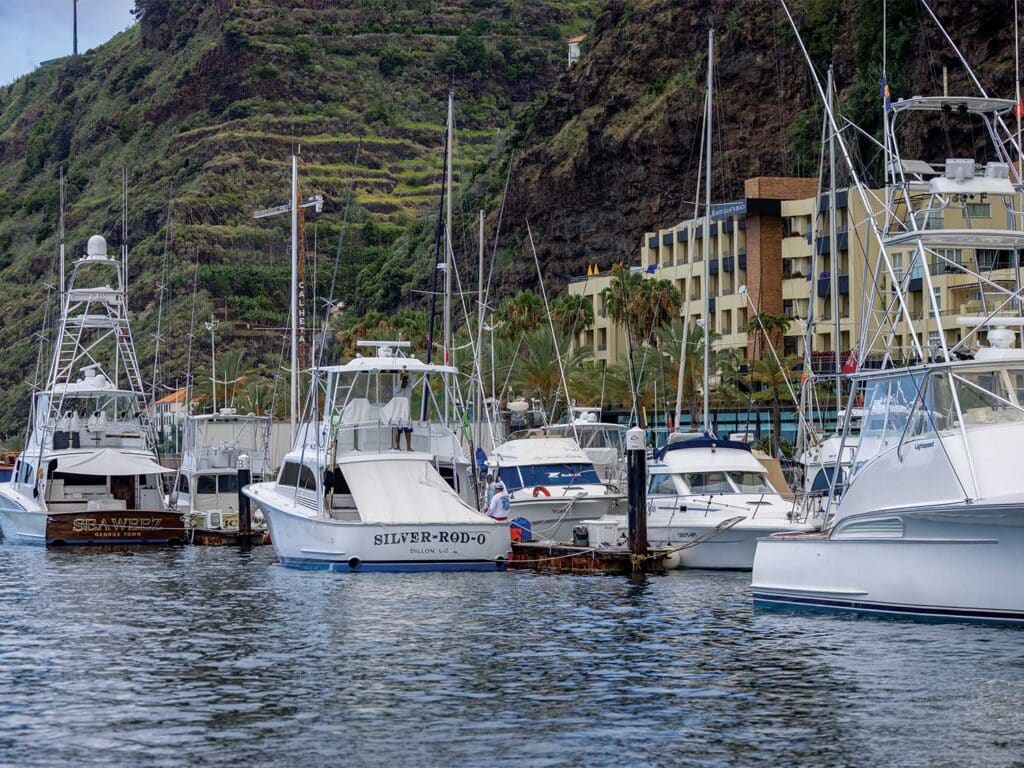
Final Say
Traveling with your boat and exploring foreign fisheries can be one of the most rewarding experiences in our sport, but making it happen successfully is a lot more complicated than picking a destination and plugging it in your GPS. Every fishing program and destination will have its own unique challenges and opportunities, but remember that there is no substitute for local knowledge. Talk to other captains who have spent time in the area you’re planning to fish, or hire a local agent to shorten the learning curve.
Packing for a long overseas trip will be dependent on the goals of your team and the resources available locally, but the safety of your crew and keeping your vessel and its systems running smoothly should be at the forefront of your decision-making. While the process might be daunting, the memory of catching a giant marlin under a foreign sky will make those sleepless nights of preparation well worth the effort.




